As the second part of the series on unethical animal tourism and what to do instead, this post focuses on land animals and birds. We will look at a series of activities from visiting zoos and animal cafés to taking selfies with the smallest primate on earth.
With great collaboration from other conscious travel bloggers, I have listed a few animal experiences you should stay away from and what to do instead.
The aim of this post is to spread awareness of unethical animal tourism activities through first-hand experiences and show you what alternatives there are. This way you can observe these animals in an ethical way with good consciousness.
This post does not include animal rides, there will be a separate post for this as it is such an important topic.
Read the first post in the series here for facts and general information about animal tourism.
Unethical animal tourism and what to do instead: land animals and birds
Meet the bold travelers who are not afraid of saying out loud that they did a mistake, but rather use their experience to educate themselves and others.
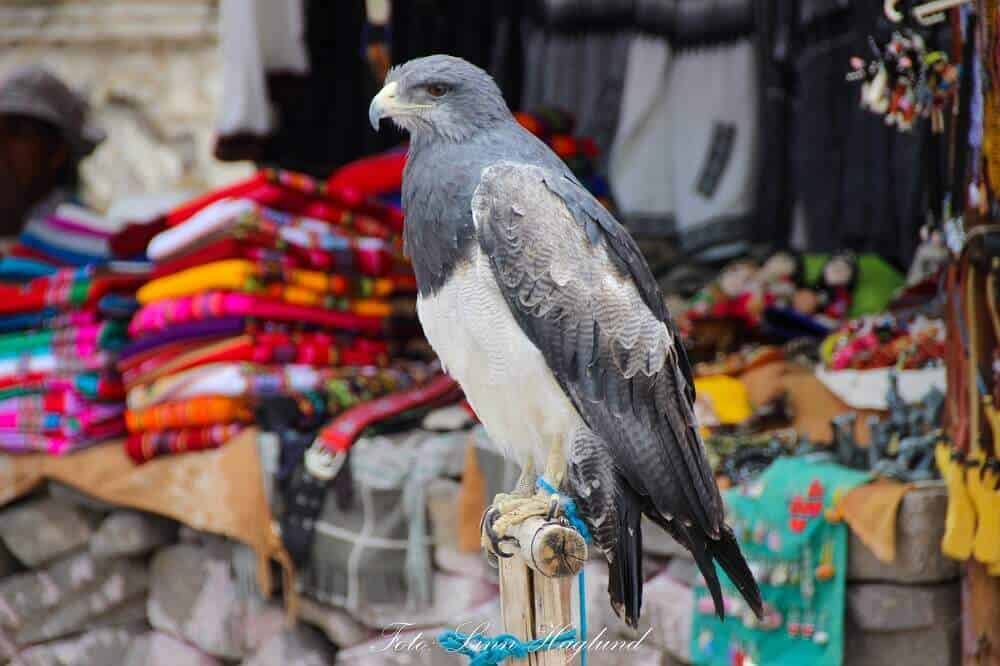
Holding sloths in Peru
By Linn from Brainy Backpackers
A few years ago I traveled to my dream destination, Peru. I was so excited to visit a village in the Amazon where a lady came over with a sloth in her arms. I asked her nicely if I could hold it and she handed him over to me.
He was so unimaginably cute with that fury little smiley face and the weird hairdo. I totally fell in love with him and his adorable slow motion.
The lady didn’t ask for any money, she just seemed happy to lend me her pet. Just as if she had a puppy I wanted to cuddle for a moment.
It wasn’t until years later, that I understood how wrong it was of me to cuddle that little weirdo.
According to a study conducted by World Animal Protection, these animals suffer stress and anxiety when handled by tourists.
With a normal sleep pattern of 8-9 hours a day for wild sloths, animals in captivity can sleep up to 15-20 hours a day. You can read more about why you should never hold a sloth here.

Ethical ways to see sloths
There are several opportunities to see sloths in their natural environment in South and Central America. The Sobrenia National Park in Panama is one option. No matter how exciting it is to see sloths in the wild, it is no guarantee and you don’t know how far away they’ll be. Nevertheless, the reward is immense.
If you want to assure you see sloths, I suggest you look up an ethical sanctuary that doesn’t allow any holding, selfies or other activities that create stress for the animals. A good alternative is AIUNAU sanctuary in Colombia. They rescue sloths from trafficking from all over the country. This is a good alternative to learn more about sloths. The sanctuary is highly caring about their animals and doesn’t allow any touching.
Tiger selfies at the Tiger Temple in Thailand
By Wendy from The Nomadic vegan
The year was 2007, and my husband (then fiancé) and I were traveling around Thailand. A couple of years earlier we had seen a documentary about the Wat Pha Luang Ta Bua Yanasampanno Temple in Thailand, more famously known as the “Tiger Temple”.
According to the documentary, the temple doubled as a wildlife sanctuary, where Buddhist monks lived in harmony with tigers and other wild animals. It sounded like a wonderful place, and we were very excited to visit.
Unfortunately, the reality was very different from what we had seen on TV. We didn’t actually see any temple buildings at all, and the odd monk or two we saw walking around seemed to be there just for show.
It was basically a tiger zoo run by international volunteers. We paid the entrance fee and then lined up to get our photos taken with a tiger, who was chained up and asleep, oblivious to us and the tourists posing with him.
The experience left a bad taste in our mouths, and we both wished we hadn’t gone, even though we didn’t fully understand at the time what we had contributed to. Years later, when we found out the truth about the Tiger Temple, we were horrified.
A police raid in 2016 uncovered dozens of dead tiger cubs that had been kept in a freezer, along with tiger fangs and amulets made from tiger skin. The monks had been illegally breeding tigers, smuggling tiger parts and exploiting the animals for financial gain.

Ethical ways to see tigers
Unfortunately, in light of the popularity of the Tiger Temple, many other exploitative tiger attractions have opened in Thailand. You really need to research attractions carefully if you want to be an animal-friendly tourist in Thailand.
Even if the attractions are not directly involved in wildlife smuggling, any forced interaction with tourists is harmful to the animals. In order to avoid maulings, the tigers are often drugged to keep them docile while tourists pose for selfies with them.
The only ethical way to see tigers is in the wild, where they belong. In Thailand, this can be difficult, as wild tigers are on the brink of extinction. Your best bet is probably Huai Kha Khaeng Wildlife Sanctuary, where there are thought to be about 90 Indochinese tigers left.
You’ll have a much better chance of a tiger sighting in India, though, where a number of national parks are well set up for tiger safaris. Try your luck at Bandhavgarh National Park, Kanha National Park or Ranthambore National Park, to name a few.
Holding Tarsiers in the Philippines
By Jing Calonge from Finding Jing
My first up-close and personal encounter with a tarsier was in Bohol back in 2009. Tarsiers are one of the world’s smallest primates endemic to the Philippines. They can be found in the southeastern Philippine islands, most popularly in Bohol.
Tarsiers have been known as a major attraction in Bohol for foreign and local tourists alike. As such, standard package tours in Bohol conveniently include a stop to a so-called tarsier conservation area.
What I knew about tarsiers back then was that they look like a crossbreed between Yoda and Gremlin (the cute, non-destructive version). At the tarsier conservation area in Loboc where we visited, we immediately saw around 3 or 4 tarsiers hanging on tree branches. The area looks more like a butterfly garden enclosed with nets where tarsiers are taken from the wild to be viewed every day by tourists.
Being one of the uninformed tourists at that time, we took turns taking photos with the poor tarsiers. One of the staff even held one tarsier to put on our palms and then above our heads, like they were domesticated pets.
What I wasn’t aware of was that this seemingly unique experience is, unfortunately, an unpleasant one for these nocturnal creatures who are supposed to be resting in the daytime.
A naive visitor that I was, it was months after when I terribly realized that I have supported an unethical tourist activity.
I watched a documentary on TV about tarsiers where they showed that species is categorized as near threatened mainly due to deforestation, hunting and illegal pet trade.
Being nocturnal primates, tarsiers are supposedly taking a rest during the day. Constant handling and noise are stressful for them. Tarsiers are also suicidal and will bang their heads to death when under severe stress.
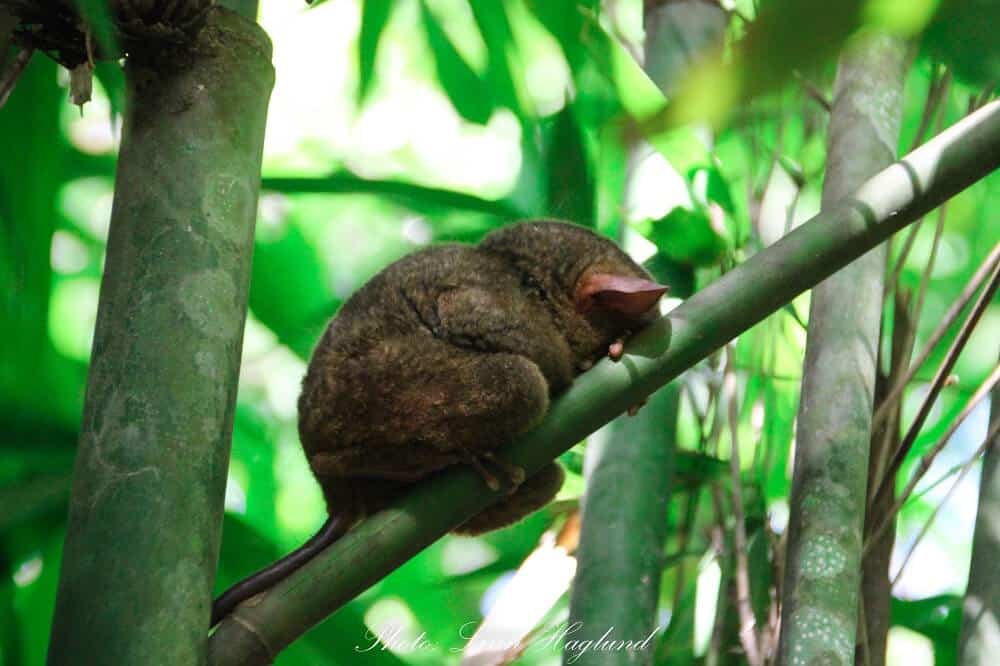
Ethical ways to see tarsiers
Do not make the same mistake I did. Do your own research before you go. Educating oneself is the first step to making informed decisions on which tour operators to support. Likewise, learning about the natural behavior of tarsiers will help us understand how to protect these delicate animals.
In 1997, the Philippine government declared the Philippine Tarsier as a protected faunal species. However, despite this proclamation, for years, some facilities claiming to be conservation areas were clearly operating under unsuitable conditions for tarsiers. It was not until 2011 when the captive tarsiers from these facilities were freed and transferred to their natural habitat.
The Philippine Tarsier and Wildlife Sanctuary, which is run by the Philippine Tarsier Foundation, Inc., has been established in partnership with the Department of Environment and Natural Resources to spearhead the conservation of Philippine Tarsiers. The sanctuary is a 167-hectare forest covering the municipalities of Corella, Sikatuna and Loboc.
They have a dedicated trail where visitors can see tarsiers in their natural habitat. They also have a research center in Corella where they receive guests to conduct proper orientation prior to the tour. These rules should be followed while inside the sanctuary:
- No flash photography
- No shouting. Observe silence at all times.
- Do not touch the tarsiers.
- No eating, drinking alcohol and smoking.
- Do not shake the tree branches.
- Do not throw any waste inside.
Besides this facility, the Rajah Sikatuna National Park in Bilar, Bohol offers night safari tours led by trained, local guides. Visitors can not only spot tarsiers while they’re hunting for food but also get a chance to see other animals like flying lemurs, civet cats, fruit bats, and owls. Proceeds from the tour will be used for educating local conservationists and for research aimed at tarsier conservation.
Read more about the topic in my post: Why you should never pet a Tarsier
Visiting owl cafés in Japan
By Liz from Curiously Abroad
From maids to ninjas, Japan has cornered the market on quirky themed cafés. Animal cafés, where customers pay to play with dogs, cats, or hedgehogs, to name a few, are some of the most popular. It was something I was intrigued to experience during my trip to Japan, and I decided on an animal infrequently seen up close: the owl.
My trip to an owl café led me down a steep, unlit staircase into underground Harajuku. Amidst the swarm of tourists, I felt the pit of my stomach sink.
There stood an owl, tethered to a perch, barely able to move. A bright light shined on him as one person after another reached out to stroke his head.
Some of the birds looked sickly and others stressed as they pulled out feathers from their already balding exterior. Some were rocking back and forth anxiously.
After 10 minutes, I reached the exit and realized I just paid 1,500 yen to see maltreated owls confined to an underground prison “café” that didn’t even serve food or drinks.
After some research back home, I was saddened to find out that many of Japan’s animal cafés are notorious for their questionable conditions. And owl cafés are some of the worst offenders.
The owls are confined to one spot and forced to stay awake during daytime hours, disrupting their natural sleep cycle. The bright lights and noise overstimulate their keen hearing and vision. Being touched is stressful for them and the oil from our hands can damage their delicate feathers.
I felt frustrated for being so easily duped by cute, gimmicky marketing and angry that hundreds of tourists are also being led astray into these establishments daily.
So, what are some ways you can ethically interact with owls?
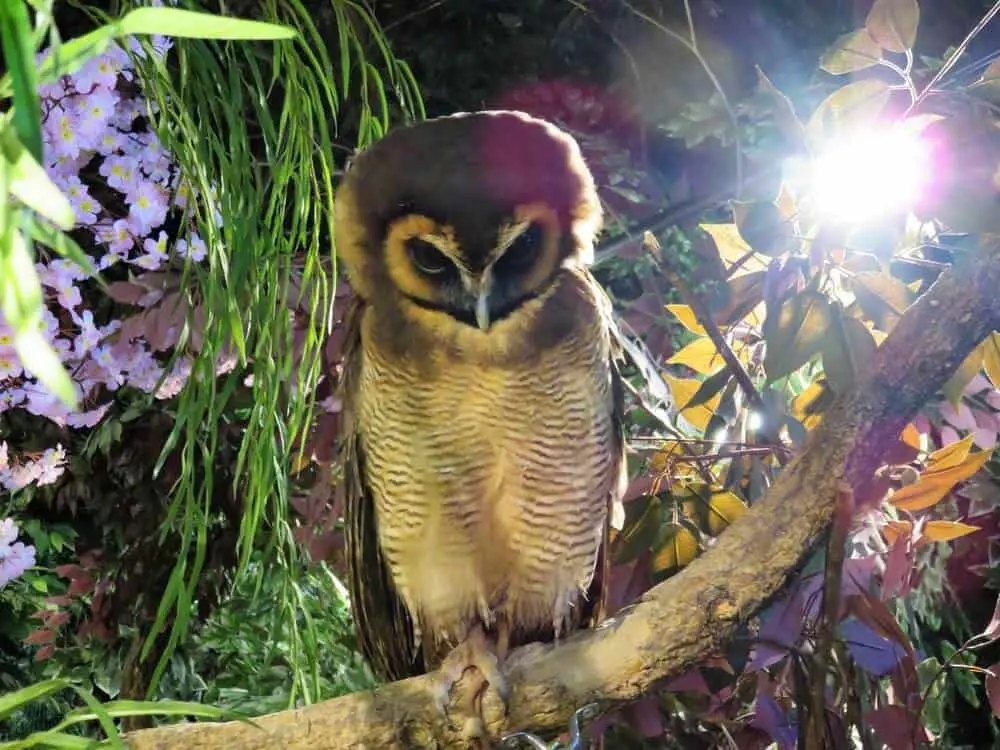
Ethical ways to see owls
Visit a Bird Sanctuary
Japan is home to several bird sanctuaries where you can see owls in their natural habitat. Joshinetsu-Kogen National Park near Nagano is home to the Karuizawa Wild Bird Sanctuary. While there, be sure to also visit the popular bathing Japanese Macaques at Jigokudani Snow Monkey Park.
To learn about Japan’s other wild bird sanctuaries, visit the Wild Bird Society of Japan’s website for more information.
Go on a Birding Tour
Birding tours walk you through areas where owls and other birds like to live. A few tour companies include:
If group tours aren’t your thing, create your own bird tour! There is a ton of information out there. Some helpful books include:
- A Field Guide To Birds of Japan
- Japan Birds: A Folding Pocket Guide to Familiar Species
- A Birdwatcher’s Guide to Japan
Visit an Aviary Park
Japan has several indoor aviary parks. Here, the owls fly around freely. For a small fee, an owl will fly over and perch on your arm. Well-known aviary parks include:
- Fuji Kachouen Flower and Owl Park near Mt. Fuji
- Kakegawa Kachouen in Kakegawa, Shizuoka prefecture
- Shimane Vogel Park in Shimane prefecture
Bonus tip: Refrain from using flash photography in dimly lit areas, as it can give the owls vision problems.
Take photos with tamed monkeys in Mexico
By Dominic Evans from Mayan Immersion
I remember when I was a child having my picture taken with a Monkey. I found it strange that the Monkey just sat there waiting patiently for the picture before moving on to the next customer. He was a real professional.
Now I know different. He was probably starved of food and beaten until he did what he was expected to do. The reason why his owner did this was so that he could earn a bit of money from tourists like us. It disgusts me now.
Ethical ways to see monkeys
Monkeys belong in the jungle. They live in the trees. Up there they are protected and they feel safe. The only reason they come down is if they really need to.
Now I live in the jungle and occasionally, maybe once every few months, I am fortunate enough to see Monkeys swinging through the trees in my garden.
If you don’t have time to hang around in my garden for a few months to wait for them to come by, I recommend visiting the Nature Reserve for Monkeys at Punta Laguna.
It is the most ethical way of seeing Spider Monkeys and Howling monkeys because they are in their natural environment as opposed to being locked in a cage and taken out for a few hours a day to pose with tourists.
The reserve has not been changed to accommodate people. If a tree falls and crosses the path, you walk around it. The whole ecosystem is kept as natural as possible.
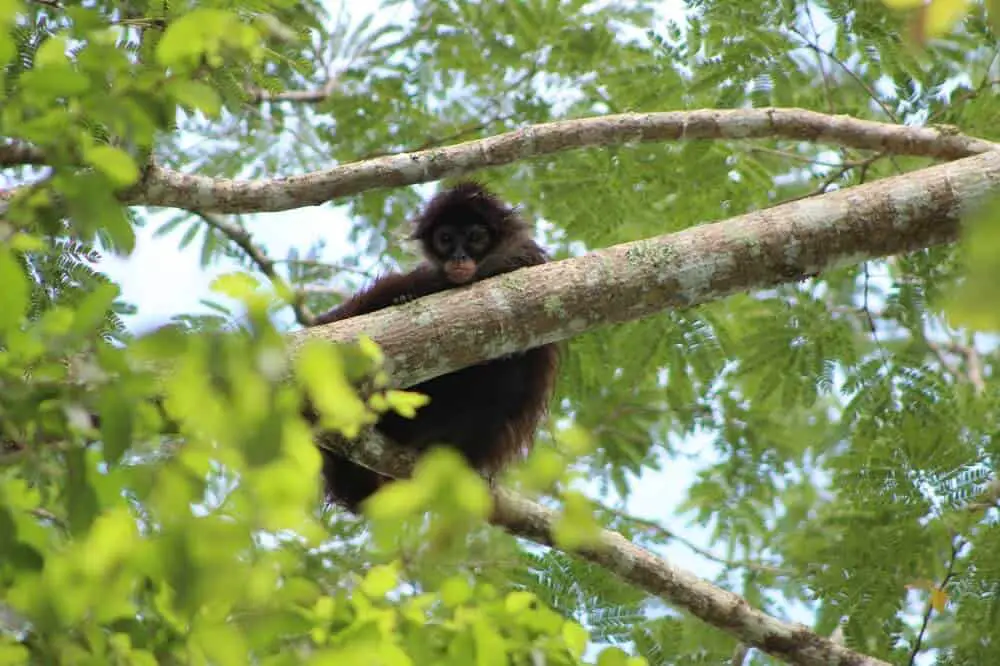
You can see how the Monkeys interact with their surroundings. Swinging from trees to find food to eat and water to drink. You can observe how the big monkey family works together to protect each other. Oh, and did I mention the little cute baby monkeys that cling to their mothers’ sides as they swing from tree to tree? They are the cutest.
The reserve is looked after by people from the local community. This way, they get the chance to keep living their traditional way of life and still earn money for a few modern necessities.
They have lived in the area their whole lives and are without a doubt the best people to look after the land.
If they couldn’t work there, they would have to go to big cities to work which again can create an unsafe environment for whole families.
In the reserve, they track the monkeys on foot and communicate with each other on the radio. This way, they can usually take you to where the monkeys are even though the animals travel large distances each day.
The experience is very much about visitors going into the monkey’s environment and observing them act and behave as they should be doing in the wild.
This is, without a doubt, the best way so see Monkeys in their natural habitat.
Visiting Yangon Zoo in Myanmar
By Monique from Trip Anthropologist
I have lived, worked and studied in Burma (Myanmar) for 25 years. In all that time a most terrible zoo has existed by the shore of Kandawgyi Lake in what was until recently the capital city, Yangon (Rangoon). As an anthropologist, I eagerly set off for the zoo in the first few months of setting up house in Yangon in 1996. Today the zoo is as bad as it was then. Animals continue to starve, to eat other animals, to be locked in small and concrete cages, tanks and enclosures.
Myanmar was a military dictatorship for much of the twentieth and twenty-first century and even now its constitution reserves a majority of its seats for the military. There is no true democracy in Myanmar and the country’s economy and riches have been stolen by generations of military generals and their families.
The Yangon Zoo is promoted as another way of relieving tourists of US dollars, a commodity that has been extraordinarily rare in Myanmar during the years of dictatorship. The zoo was also one of the few places that young people could legally gather in public and so it was a place I could conduct fieldwork in relative safety.
This, of course, led me to realize the state of the animals. I have been concerned about the lives of people living in poverty and under repression, but it hadn’t occurred to me to spare a thought for the lives of the animals in the Yangon Zoo.
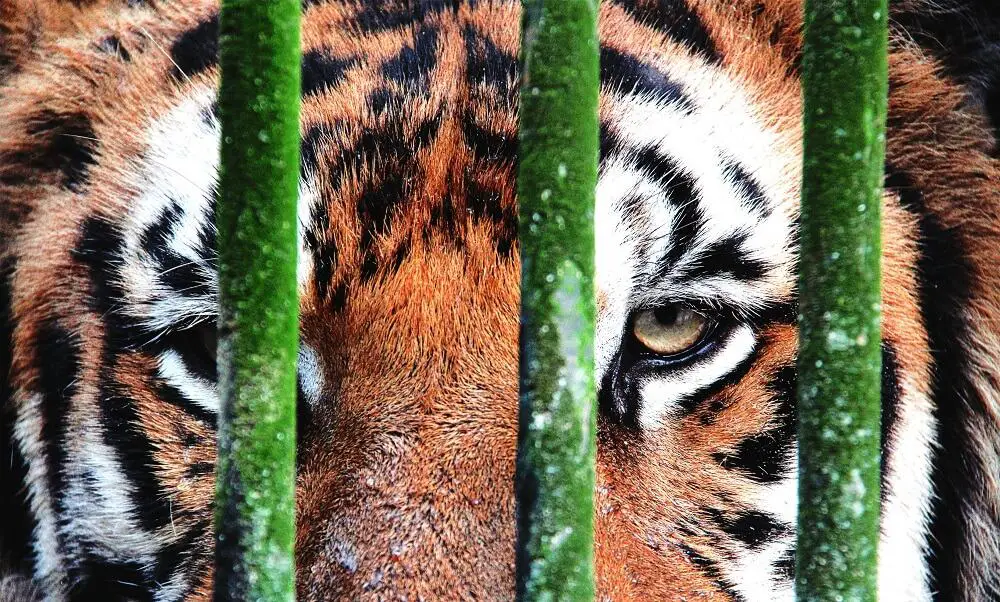
How to see wildlife in an ethical way in Myanmar
Animals are often not treated well under Buddhism, at least in Myanmar; they are lower on the karmic cycle of rebirth than humans. Stray dogs and monkeys are particularly mistreated in Myanmar.
Boycotting this zoo is an important first act in creating a better environment for the animals. The zoo is about to open an “elephant museum” and this should also be boycotted. The trafficking of wildlife in Myanmar has reached astounding proportions and you should not purchase tiger teeth, ivory or any Chinese traditional medicine or animal products in Myanmar and around its borders with Thailand, China, and India.
Unfortunately, Myanmar is not yet at a stage in its development where it is possible to see and interact with animals in an ethical way and avoidance and advocacy are currently the best ways to deal with this distressing issue.
Admin: If you want to see wildlife in Myanmar I recommend taking an organized tour with an ethical tour operator. Make sure you do your research well!
Conclusion
The one thing I get out of the above stories is that it is important to learn about the sanctuary you visit as well as the species and its needs before you decide on any activity including wildlife.
A good question to ask yourself is “what does the animal benefit from this” instead of focusing on what you benefit from it first.
Because we all want the same: to get as close as possible to a beautiful animal. If you’re not sure if the activity is ethical, research it. In case you’re still unsure after that, I’d say skip it.
Luckily, more and more places are becoming conscious about responsible tourism activities and the number of eco tourism destinations taking animal rights serious are growing.
Read next: Unethical animal tourism and what to do instead: Marine life
Pin it for later!

